 |
|

|
 |
TABLE of CONTENTS
|
Legislature adjourns after passing capital investment bill |
By Erik Rudeen, state legislative liaison
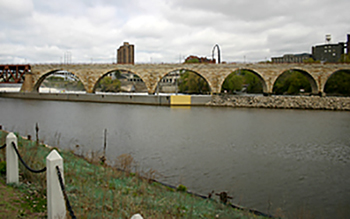
The legislature passed the capital investment bill, which approves $1 million for the Stone Arch Bridge in Minneapolis. Photo by David Gonzalez |
The legislature adjourned sine die a few minutes before midnight May 20, shortly after passing a capital investment bill. The bill’s fate was in doubt because it requires a super-majority of votes to pass, meaning it requires bipartisan support in both the House and Senate.
Several transportation items are included in the capital investment bill:
- $400 million for the Corridors of Commerce program
- $78.6 million for local roads, including earmarks for projects at Hwy 10/Thurston Avenue in Anoka, I-94/Brockton Lane in Dayton, Argenta Trail in Inver Grove Heights and Hwy 101 in Carver County
- $10.5 million for a rail grade separation on Hwy 29 in Glenwood
- $9.72 million for Rockford Road over I-494 in Plymouth
- $5.2 million for ports
- $5 million for local bridges
- $5 million for environmental cleanup along Hwy 10 in Wadena
- $4 million for Hwy 169/101st Avenue in Brooklyn Park
- $3.3 million for industrial park improvements in Becker
- $3 million for Hwy 8 in Chisago County
- $2.5 million for a bus garage in Rochester
- $1 million for the Stone Arch Bridge in Minneapolis
- $1 million for Safe Routes to School
- $830,000 for Hwy 169 in Mankato
- $600,000 for a Wakefield Township road
- $500,000 for Hwy 23 in Foley
- Funding for several rail projects, including a bridge over Rice Creek in New Brighton, track rehabilitation on the Minnesota Valley line, and rail crossing improvements in Goodview, Moorhead, Rosemount, Loretto, Medina, Wayzata and Ramsey
The department requested $40 million for buildings around the state, but the bill did not include any funding for MnDOT facilities.
The Corridors of Commerce projects provide an additional $400 million for three projects, two in Greater Minnesota and one in the Twin Cities metro area. Corridors of Commerce, established by the Legislature in 2013, is intended to improve the state transportation system in ways that specifically support Minnesota’s economy. The projects that will completed over the next four years are:
-
Hwy 14, Owatonna to Dodge Center (Greater Minnesota) – estimate up to $160 million
This project will expand Hwy 14 from two lanes to four lanes between Owatonna and Dodge Center, thus completing a continuous four-lane roadway between I-35 and Rochester. The proposed project is intended to improve the capacity, safety, travel times and access to Rochester. Hwy 14 previously received more than $58 million in Corridors of Commerce funding for road improvements.
-
Hwy 23 (Greater Minnesota) – estimate up to $105 million
This project will complete two gaps to create a continuous four-lane roadway from Willmar to St. Cloud. The two locations are from New London to Paynesville and from Paynesville to Richmond. The project will improve roadway capacity, safety, travel times and interstate access to west central and southwest Minnesota residents and businesses.
-
Hwy 252 and Interstate 94, Hwy 610 to Dowling Avenue (Metro District) – estimate up to $163 million, including up to $31 million in committed local funding.
This project will convert Hwy 252 to a freeway and install MnPASS lanes on the roadway. The proposed project is intended to improve the capacity of this key corridor and dramatically improve the trip time reliability of the average rush hour trip.
“It is fortunate that the Legislature provided additional funding for this program this year,” said Commissioner Charlie Zelle. “These were the next projects in line to be funded, according to guidance in state law from last year and this bonding bill. The selected projects will enhance the movement of freight and people in the regions where these projects are located, which will aid the economy and reduce congestion.”
The Legislature also passed a nearly 1,000-page omnibus supplemental budget bill that included numerous funding and policy provisions. The omnibus bill included several MnDOT initiatives like trunk highway turn backs, contracting modifications, truck weight changes and updates to airport zoning laws. Governor Dayton vetoed the bill after warning the Legislature several times not to send him legislation containing controversial policy items.
A one-year moratorium on enforcing permits to mow and hay trunk highway rights of way passed and has been signed into law. After much discussion and strenuous opposition, the Legislature decided not to place a constitutional amendment proposal on this fall’s ballot to dedicate auto parts sales taxes to roads and bridges. It also failed to enact a hands-free cell phone law despite significant support. Despite leaving much work unfinished, legislators did manage to ratify state employee contracts and enact important reforms to the state employee pension system. |
 |
|

|
 |
TABLE of CONTENTS
 |
Public engagement on Hwy 14/15 New Ulm Gateway leads to better engineering |
By Rebecca Arndt, District 7 public engagement coordinator
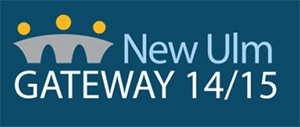
|
When the 2008 Chapter 152 funds were made available to replace the Hwy 14/15 bridge over the Minnesota River in New Ulm, it provided the opportunity to complete another piece of the four-lane between New Ulm and Rochester. The adjacent four-lane bridge over Front Street and the railroad was later identified for replacement through the regular bridge program. The proximity of the projects made it obvious that they should go together as a single $43 million to construct two four-lane bridges.
This presented District 7 with a challenge and an opportunity. Just north of the river bridge lies the intersection of Hwy 14 and Hwy 15, known locally as the “Y." This intersection experienced several fatal crashes in the 1990s and, despite minor modifications in 2003, it continued to have a high-injury crash rate. With a major detour already needed for the bridges, it would be the perfect opportunity to fix the Y. The challenge? No funding was available to improve the intersection.
“On the one hand we had a community where we were often reminded that it is the largest city in Minnesota without a four-lane highway coming to it and that the Highway Department has been promising this since the 1950s,” said Peter Harff, assistant district engineer. “On the other hand, we had a traffic engineer (Marc Flygare) who had worked for years to improve safety at the intersection and stated that he could retire in peace if we could just fix the Y, but we didn’t have the funds to do both.”
In response to this challenge, the district looked to the community to help with the difficult decisions it needed to make. Commissioner Charlie Zelle sent letters to city, county and business leaders asking them to participate in the Hwy 14 New Ulm Task Force. As stated in his letter, the goal of the task force was to “help develop a comprehensive plan that identifies and addresses the highest priorities of the community in the most cost effective manner.”
In the course of five facilitated task force meetings the members learned about each other’s varying perspectives and needs, and poured over traffic information, costs and impacts to the New Ulm area. When the time came to provide recommendations to MnDOT, the decision was unanimous – construct two-lane bridges and use the cost savings to construct an interchange to replace the Y.
That decision then created a challenge for the local task force members.
“The mayor of New Ulm came to me asking, ‘How could I ever support anything other than a four-lane?’ but he did,” said Greg Ous, District 7 engineer. “That’s when the success of this partnership became clear to me.”
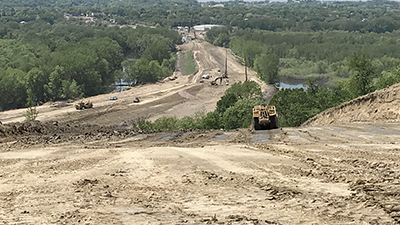
The Gateway New Ulm project will replace the New Ulm Minnesota River and Front Street bridges, along with building an interchange at the Hwy 14, Hwy 15 and County Road 21 intersection. Photo courtesy of District 7 |
Task force members took ownership of their recommendations, even participating in public open houses where they defended the decision to build two-lane bridges in order to use those funds to take care of the Y.
“Though there still are those who remain skeptical, the majority of the public and news media supported the approach being taken to the improvements of the project given the limited funding,” said Zak Tess, project manager. “Municipal consent of the project layout passed unanimously from the city of New Ulm.”
Working with the task force to make high-level decisions was just the beginning of public engagement on this project. Several rounds of public meetings and open houses took place to get input into the details of the road designs. When it came to the aesthetics of the New Ulm Gateway, a survey went through social media that allowed more than 1,500 citizens to weigh in on what this community should look like at the gateway to the city.
A steering committee was formed with local partners to determine the best construction staging and subsequent detours. This information was taken to the community in several formats. One of the most popular was joining their National Night Out at German Park where project staff connected with a couple hundred residents. To reach the more rural members of the area, they also had a presence at the Brown County Fair in New Ulm.
The strong connection that developed with the community even allowed for a little fun. Hermann the German, the chieftain who led the Germanic tribes to victory over the Romans in the Battle of Teutoburg Forrest and the subject of the iconic statue in New Ulm, is featured in videos produced for social media to kick off each year’s construction and detours. In the videos, Hermann joins other members of the community as they successfully navigate the detours to participate in one of the many annual festivals in New Ulm.
Throughout construction, the public will be able to continue to follow the project by means of a live web cam, weekly public meetings, email updates and a New Ulm construction web page. In addition, Todd Kjolstad, construction supervisor and business liaison, works closely with the New Ulm Chamber and provides updates at their meetings.
“The free flow of information and ideas between MnDOT staff and the public led to a better project, improved staging, and easier navigation during construction; that’s why we do this,” said Ous.
This video explains the New Ulm Gateway construction project and the detour route in 2018.
The project is addressing intersection safety, aging bridges, poor pavement conditions, and occasional road flooding around New Ulm. Video courtesy of District 7 |
|
 |
|

|
 |
TABLE of CONTENTS
 |
Owatonna demo day highlights summer maintenance equipment |
|
By Sue Roe
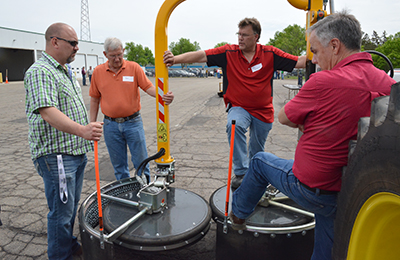
Craig Gertsema, left, District 8 maintenance superintendent, and Dave Johnston, District 8 maintenance engineer, talk with Kevin Bergstedt, Metro District transportation program specialist and equipment coordinator, and Cliff Gergen, Metro District transportation operations supervisor, about the machine that mows around cable median barriers. The employees attended the summer maintenance demo day in Owatonna May 23. Photo by Sue Roe |
Loud sirens, the buzzing of a drone, crashing of trees and crunching of tree trunks and branches were some of the sounds at MnDOT’s annual maintenance summer demo day May 23. The event, held in District 6 at the Owatonna headquarters, highlighted some of the technology and equipment used during summer maintenance operations.
Districts brought 27 pieces of equipment to the event. More than 200 people attended, which included employees from cities and counties.
Five of MnDOT’s eight districts brought a variety of machines including mowers, sprayers, tree saws and other equipment with names such as brush hog, dingo and menzi muck. There was also equipment used in work zones such as a cone setter, radar trailer, cable median barrier spreader and work zone alert system. Road maintenance equipment included a mill and conveyer and microsurfacer.
“There’s a lot of ‘wow’ here,” said Ron Heim, Owatonna subarea supervisor. “There’s big equipment and specialty equipment all in one place. There’s been a lot of different conversations going on today with operators, employees and vendors.”
The Iowa Department of Transportation demonstrated a mobile work zone alarm system, which is being considered by MnDOT. The system alerts workers by sounding a siren-like alarm when a vehicle enters the work zone.
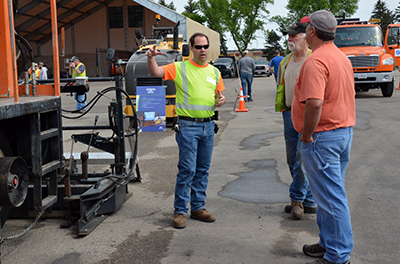
Mike Durand, left, Metro District, talks to Dave Srp and Brad Peterson, both of the District 6 Albert Lea Truck Station, about the microsurfacer that Metro District uses to resurface roads. Metro currently shares the equipment with District 3. Photo by Sue Roe |
Another work zone intrusion alert system shown provides advanced warning to workers by activating a signal that is sent to a personal warning device. The system is part of MnDOT’s Maintenance Operations Research program.
“It’s a low-cost system we’re evaluating now,” said Steve Blaufuss, statewide maintenance work zone and operations specialist. “We’re extending the project evaluation so we can try it on specific jobs in the field.”
A forestry cutter mulched a standing tree from the top down in seconds, throwing the material away from the machine so that it’s safer for operators.
A remote control slope mower slowly moved up a steep slope, mowing grass and small brush along the way, showing it could be used in difficult terrain. District 2 rented the mower previously as part of the Maintenance Operations Research program.
“I liked seeing the remote control mower,” said Curt Hortop, District 6 transportation generalist. “Just to see the variety of things and pick other district employees’ brains is valuable. It’s nice to see what other districts are using in the state.”
Different types of mowers were showcased, including one that can mow in wetlands and another one that can mow around guardrails.
The mower used in wetlands is coming in handy for the Albert Lea Truck Station, which brought the mower to demo day.
“In Albert Lea, we have three state monuments we maintain plus weigh station scale sites on Interstate 35, so we can now get to these areas on a more regular basis because we are not having to let these areas dry out as much,” said Brad Peterson, transportation generalist senior.
Tina Markeson, roadside vegetation management supervisor, presented information about vegetation management. Jennifer Wells, bridge inspection engineer, talked about bridge drone inspections and later demonstrated a drone. Bryan Lillie and Mark Larson, both of District 7, showed mastic asphalt samples.
Wendy Grant, Metro transportation generalist from the Golden Valley Truck Station, was on hand with co-worker Earl Jones to talk about Metro District’s truck for setting cones. It’s the only one of this style in the state.
Grant said she enjoyed talking with other employees and seeing what other people do at MnDOT.
“It’s putting together a lot of equipment you don’t normally see. I like doing this. It’s beneficial,” she said. |
 |
|

|
 |
TABLE of CONTENTS
 |
Scenic Byways offer a variety of vacation options |
By Judy Jacobs
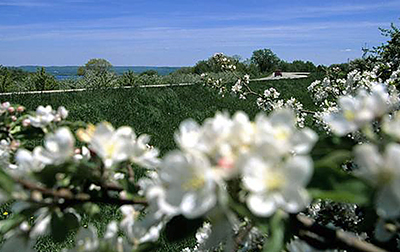
Apple Blossom Scenic Drive is just one of 21 Scenic Drives in Minnesota. Located in the bluff lands of southeastern Minnesota this byway features river valley views and apple orchards. Photo courtesy of Explore Minnesota Tourism |
Minnesota’s Scenic Byways Program has worked collaboratively with the Federal Highway Administration’s National Scenic Byway Program and the National Scenic Byways Foundation to create distinctive travel destinations throughout the state.
The Scenic Byway designation is recognized for its potential to positively affect the cities and towns located along the routes. Many communities benefit due to a Scenic Byway route, including increased economic benefits, improved traveler and community services, and broadened appreciation of Minnesota’s historic and natural resources.
Minnesota has 21 Scenic Byways that cover almost 2,900 miles of roads across the state.
MnDOT is one of several agencies that oversee Minnesota’s Scenic Byway Program, which was established in 1992. Others are the Minnesota Department of Natural Resources, the Minnesota Historical Society and Explore Minnesota Tourism.
“These byways give travelers a chance to discover Minnesota’s scenic beauty, nature, history and culture by a variety of travel modes,” said Commissioner Charlie Zelle. “Each byway offers something special—an opportunity to experience small town-main street charm, historic sites, state parks and trails, local arts and more. The program is looking ahead to determine how best to sustain the qualities that make these routes worthy of the experience – by all modes of travel.”
Other important attributes of a Scenic Byway include support for managing and maintaining these historical and natural resources, improved management of resources to accommodate visitors, and vigilant stewardship of the byway corridors.
Visit MnDOT’s Scenic Byways website at www.mndot.gov/scenicbyways/index.html for information about Scenic Byways locations and what each has to offer. |
 |
|

|
 |
TABLE of CONTENTS
 |
Donald Obernolte, Patty Johnson eligible for vacation donation |
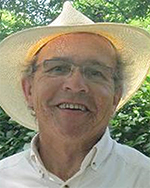
Donald Obernolte, Office of Environmental Stewardship, is eligible for the state vacation donation program. Photo courtesy of the Office of Environmental Stewardship |
Donald Obernolte, Office of Environmental Stewardship, and Patty Johnson, District 3 maintenance, are eligible for the vacation donation program.
Obernolte has worked for MnDOT for 21 years. He suffers from a number of medical conditions including chronic pain, difficulty breathing, respiratory distress, difficult sleep, and heart conditions that stem from life threatening injuries sustained as the result of a massive blunt force trauma caused by a tree falling on him twice, crushing him with more than 60 fractures in his body, punctured lungs, bruised heart, stretched aorta and many implants and residual defects throughout his body that continue every day.
Due to his injuries, Obernolte has many specialist, therapists, medical appointments and therapeutic interventions many times each week. Since January 2018, five additional surgeries have been required.
Johnson is a transportation specialist, who has worked for MnDOT for more than 30 years. She works with St. Cloud maintenance operations/roadway regulations.
Johnson was diagnosed with a life-threating illness in September 2016.
Also eligible for the vacation donation program are MnDOT employees Kyle Goosman, District 8 transportation generalist senior; Racheal Glancy, Project Delivery Division, Melissa Janzen, Office of Land Management, and Tim Gilder, Metro District maintenance supervisor. Goosman, has been with the Willmar maintenance team for more than five years and has colon cancer; Glancy has more than 19 years of state service and has chronic heart failure. Janzen has worked at MnDOT since 2016 and has a life-threatening illness. Gilder is a 27-year employee of MnDOT and has Parkinson’s disease.
To donate vacation hours, go to the Employee Self Service Web site and click “Other Payroll” and then “Leave Donations.” The site also allows employees to view a list of all state employees eligible for the program and to enroll as a recipient. |
 |
|

|
 |
TABLE of CONTENTS
 |
Michael Kalnbach named new ADE in District 1 |
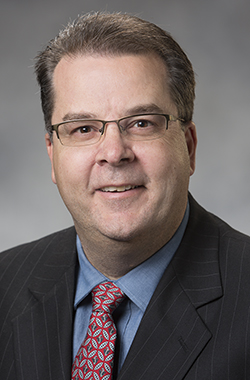
Michael Kalnbach is the District 1 assistant district engineer for program development. Photo courtesy of District 1 |
Michael Kalnbach has been appointed the District 1 assistant district engineer for program development.
This new role for the district management team consolidates management responsibilities for planning, project support and project management.
Kalnbach has 23 years of experience working in the transportation industry, including the last nine years with District 1.
“Michael has several years of experience working in planning, development and leadership, which will make him a valuable addition to the management team,” said Duane Hill, District 1 engineer. “His new role will be responsible for improving the work planning portion of our program delivery process.”
Most recently, Kalnbach has led the District 1 project management unit. He has a bachelor of science degree in civil engineering from North Dakota State University.
Kalnbach moved into his new role May 16. |
 |
|

|
 |
TABLE of CONTENTS
 |
WIG coachesí workshop includes presentation on Gray Area Thinking |
By Judy Jacobs
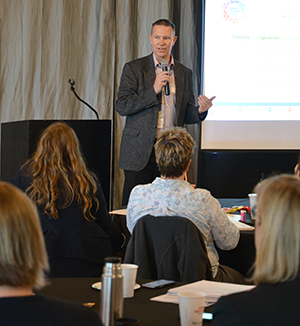
Eric Davis, chief of staff, welcomed over 50 WIG 2.0 coaches to a workshop held May 10. Photo by Judy Jacobs |
On May 10, Eric Davis, chief of staff, welcomed more than 50 WIG coaches, WIG champions and MnDOT leaders to a coaches workshop.
“WIG efforts have once again made demonstrated gains in advancing equitable workforce and contracting practices as well strengthening customer relationships,” Davis said. “Our next efforts, as an agency, will involve aligning the WIG with the implementation of MnDOT’s Strategic Operating Plan in a measurable and meaningful way.”
Richard Davis, director, and Renee Raduenz, market research manager, Office of Public Engagement and Constituent Services, presented a draft version of a “close out” customer engagement survey, focused on the Improving Intentional Customer Engagement priority of WIG 2.0. This survey is designed to measure the impact of MnDOT’s efforts to improve customer involvement, impact and experience. The survey will be sent internally first and then to external customers, partners and stakeholders in late July. Results are anticipated to be released in late 2018.
“We have to take time to put our WIG 2.0 successes back into the whirlwind,” said Richard Davis. “We want to be intentional about evaluating and capturing what worked and what didn’t. It’s important for setting the stage for implementing priorities around Customer Trust from MnDOT’s 5-year Strategic Operating Plan.”
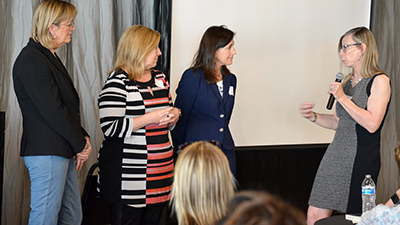
Cheryl Hunstock, transportation program specialist, Land Management; Karin Van Dyck, director, Human Resources; Nancy Daubenberger, assistant commissioner, Engineering Services, participate in an interactive exercise with guest speaker, Ellie Krug at the WIG 2.0 coaches meeting. Photo by Judy Jacobs |
Coaches participated in an exercise that will help them assist their teams with putting WIG 2.0 back into the whirlwind. A worksheet has been designed to ensure that each WIG team can capture and transition its successful sub-WIGs and maintain the improved products or processes in its daily work.
Led by AnneMarie Burgess, WIG team coaching manager, coaches discussed ways to incorporate their team’s successful sub-WIGs’ new products or processes into the way MnDOT does business, to think about how previous products or processes have been improved, how to maintain these improvements and keep the momentum going.
Ellie Krug, self-described writer, lawyer and human, led the coaches in an interactive session about Gray Area Thinking. She guided coaches in how to recognize when our brains instinctually label and categorize other people, how to use this natural phenomenon as an opportunity to act with more compassion and empathy and how this, in turn, can lead us to live and work with more inclusivity.
Klug wove her own life experiences into the session and involved participants in powerful activities that demonstrated her inclusivity model in action.
“We believe this action-focused, relationship-based and shame-free model is a great tool to use as a next step for our coaches as change agents,” said Burgess.
Klug is the author of Getting to Ellen: A Memoir about Love, Honesty and Gender Change (2013). For more information on Gray Area Thinking, visit Krug’s website. |
 |
|

|
 |
TABLE of CONTENTS
 |
Commissionerís Staff Diversity and Inclusion committee hosts outreach opportunity for local students |
By Adrien Carretero, Government Affairs
Eighth grade students from Farnsworth Aerospace School in St. Paul visited the High Bridge construction project on Smith Avenue May 1 to explore career opportunities in the highway-heavy industry.
Farnsworth Aerospace School provides Pre K-8 education to communities with lower income and focuses on engineering careers.
This visit was organized by the Commissioner’s Staff Diversity and Inclusion Committee, which works to encourage cultural competency in everyday practice and promotes MnDOT’s vision to build a diverse, highly qualified workforce. Part of this mission is to provide hands-on education opportunities and outreach to students from diverse communities.
Greg Asche, project engineer, and Nate Flogel, contractor project engineer, guided students through the project’s scopes of work. They talked about career opportunities for women and men, including project managers, crane operators and laborers.
The students were surprised by the diverse types of work and salary ranges. As the students were able to get closer to the bridge, they could see the concrete segments used for the bridge deck resurfacing. They learned about the weight that could be sustained by the pillars and the crane pulley. They also asked questions about the length and height of the bridge and expressed interest about the environmental impact of the construction.
The partnership MnDOT has with Farnsworth provides an opportunity for participating students to explore possibilities of what an education can bring, expands their imagination and provides hands-on discovery.
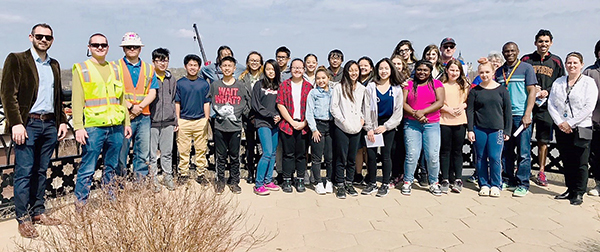
Students from Farnsworth Aerospace School recently visited the High Bridge construction project in St. Paul and learned more about career options. Photo courtesy of the High Bridge garden club |
|
 |
|

|
 |
TABLE of CONTENTS
 |
Snowplow operator profiles, winter driving infographic receive communications awards |
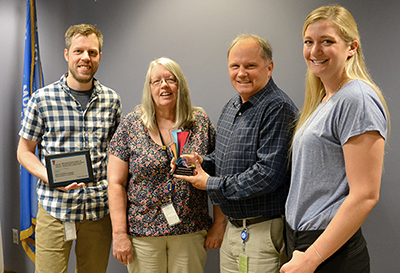
Adam Oie, Sue Roe, Rich Kemp and Kristi Loobeek, Office of Communications, were recognized May 17 at the annual Minnesota Association of Government Communicators Northern Lights Banquet for communications projects that helped educate motorists about MnDOTís winter maintenance operations. Photo by Mary McFarland Brooks |
Office of Communications staff received two awards May 17 from the Minnesota Association of Government Communicators in recognition of efforts that helped educate and provide timely information to motorists about Minnesota winters and MnDOT’s winter maintenance operations.
The “MnDOT Snowplow Operator Profiles” entry shared top honors in the Social Media Engagement category with an entry from Metro Transit. Sue Roe, project manager and editor; Rich Kemp, videographer; and Kristi Loobeek, social media coordinator, received the Northern Lights Award for six videos and five print profiles of MnDOT snowplow operators they created and pushed out via Facebook, Twitter and YouTube during the 2017-18 winter.
“Snowplow operators are the overlooked heroes of the north. It is not uncommon to hear the public reference the trucks as if they drive themselves—‘Where are the snowplows?’” said Loobeek. “Our goal was to bring awareness to the hardworking people behind the wheel. By putting a face to our fleet, we hoped to build appreciation and understanding for a job that requires long and odd hours. As an added bonus, we wanted to give the public first-hand winter driving tips by quoting our plow drivers.”
On Facebook, the profiles reached 179,063 people and received 515 shares; they generated 40,662 impressions on Twitter and received 47 retweets. Click here to view examples of the Facebook and Twitter profile posts.
Adam Oie, acting web and graphics supervisor, received an award of merit in the One-page Publication category for the “Winter Driving Safety Tips Infographic.” The infographic was part of a larger multi-agency public information campaign, “Know Before You Go,” leading up to Super Bowl LII in February.
“Audiences for this infographic were primarily the out-of-towners and service drivers (Lyft, Uber, taxi cabs), especially those who are not experienced in driving in winter conditions or around snowplows,” said Oie. “Visuals were a fun way to show drivers what they may see on the road and to give tips and instructions directly related to those things.”
“I am very proud of these award winners, and the rest of the communications staff,” said Kevin Gutknecht, Communications director. “Day in and day out they produce vital information to keep the public aware and to ensure that the MnDOT story gets out. It is great to see them recognized by a jury of their peers.” |
 |
|
| |
|



